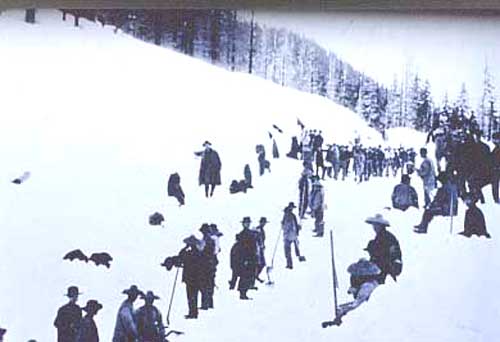
On May 10, 1869, thanks to an army of thousands of Chinese and Irish immigrants, who laid 2,000 miles of track, the nation’s first transcontinental railway line was finished by the joining of the Union Pacific and Central Pacific lines at Promontory Point, Utah.
On this day, the presidents of the Union Pacific and Central Pacific railroads met at Promontory Point and hammered in a ceremonial last spike to connect their rail lines. This made transcontinental rail travel possible for the first time in U.S. history. Eastern- or western-bound travelers no longer needed to take the long and dangerous journey by wagon train.
In a prime example of “corporate welfare,” one year into the Civil War, Congress passed the Pacific Railroad Act (1862), guaranteeing public land grants and loans to the two railroad companies it chose to build the transcontinental line, the Union Pacific and the Central Pacific. Earlier, in 1853, Congress had appropriated funds to survey possible routes. With the money in hand, the two railroads began work in 1866, heading west from Omaha, Neb., and east from Sacramento, Calif., forging a northern route across the country. In their eagerness for land, the two lines built right past each other, and the final meeting place had to be renegotiated.
Harsh winters, staggering summer heat, raids by Indians angered that their land was being taken, and the lawless, rough-and-tumble conditions of newly settled western towns made conditions for the Union Pacific laborers – mainly Civil War veterans of Irish descent – miserable. The overwhelmingly immigrant Chinese work force of the Central Pacific likewise suffered, including enduring brutal 12-hour work days laying tracks over the Sierra Nevada Mountains. On more than one occasion, whole crews were lost to avalanches, or accidents with explosives would leave several dead.
For all the adversity they suffered, the Union Pacific and Central Pacific workers finished the railroad by 1869, ahead of schedule. Journeys that had taken months by wagon train or weeks by boat now took only days. Their work had an immediate impact: The years following the construction of the railway were years of rapid growth and expansion for the United States, due in large part to the speed and ease of travel that the railroad provided.
Photo: Chinese railroad workers in the snow. Wikimedia Commons












Comments